
- Usage in publication:
-
- Snake Hills formation
- Modifications:
-
- [Original reference]
- Dominant lithology:
-
- Limestone
- AAPG geologic province:
-
- Basin-and-Range province
Summary:
zzzzzPg. 148. Snake Hills formation of El Paso group [author does not capitalize rank terms; however, units are considered formal]. Largely barren thin-bedded limestones. Overlies Mud Springs formation (new) and underlies McKelligon formation (new). Age is Early Ordovician (middle Canadian; Demingian). Canadian treated as a system in this report. Author states that his philosophy of nomenclature is contrary to "the present fashion of delimiting formations on lithology alone." The resulting proposed divisions of the El Paso Group are thus "a succession of strata and faunas."
Well exposed in Snake Hills southwest of Deming. Named from Snake Hills. Type locality not designated.
[Discrepancy: this is classified as a formal proposal of name in US geologic names lexicon (1970, USGS Bull. 1350, p. 703); is classified as an informal proposal and "first published use" of name by GNU staff (1988, USGS DDS-6; Denver GNULEX), indicating it does not meet nomenclatural guidelines for proposing a formal name. This change in classification is not addressed by GNU staff. --unresolved.
According to GNU records (USGS DDS-6; GEONAMES), the Snake Hills is considered a formal formation of the El Paso Group in NM and TX (explanation and reference not given). --unresolved.]
Source: US geologic names lexicon (USGS Bull. 1350, p. 703); GNU records (USGS DDS-6; Denver GNULEX).
For more information, please contact Nancy Stamm, Geologic Names Committee Secretary.
Asterisk (*) indicates published by U.S. Geological Survey authors.
"No current usage" (†) implies that a name has been abandoned or has fallen into disuse. Former usage and, if known, replacement name given in parentheses ( ).
Slash (/) indicates name conflicts with nomenclatural guidelines (CSN, 1933; ACSN, 1961, 1970; NACSN, 1983, 2005, 2021). May be explained within brackets ([ ]).

